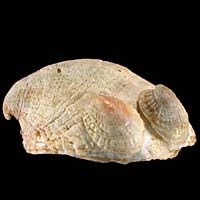|
< Previous family introduction |
|
|||||
 |
Family Hipponicidae Horse hoof limpets |
|||||
|
The horse-hoof limpets are one of the families in which shells have assumed a limpet shape, but the anatomy of the animals is far removed from that of the true limpets. A spirally coiled apex remains, although this is often eroded away. Hipponicids are sedentary animals, mobile as juveniles, but once a spot has been selected they remain more or less fixed in position for life. Some secrete a calcareous basal plate, so are actually bivalved gastropods! Some species attach themselves to a rocky substrate, and others to shells, which are inhabited either by the original mollusc or by a hermit crab. Those attached to the substrate feed by grasping passing debris. Those attached to shells feed either on the waste of their host, or take advantage of the movement of their host to access fresh areas of organic detritus. Species may have separate sexes or be consecutice hermaphrodites, usually male at first and then female; the hermaphroditic species often have small males living on the shells of larger females. Eggs are brooded in the mantle cavity of females, and emerge as crawling juveniles or possibly as planktonic larvae. The taxonomy of the Australian species is poorly known. There appear to be species complexes in the tropical Indo-West Pacific region reaching into northern Australia, and perhaps in southern Australia. The number of species, their distributions, characteristics of the shells and habitats is yet to be determined. Two papers by Knudsen (1991, 1993) provide very useful information on anatomy and habitat of two populations in south-western WA, but there has been no work to determine the distributional ranges or correct names for the species he studied. Lack of definition of the species has led to species names being used in a confused manner. Four species are known from NSW. There are two Hipponix species; one is tropical and just reaches into northern NSW, while the other is southern Australian and just reaches into southern NSW from the south. The third species, Antisabia aff. foliacea, is common throughout NSW intertidally and in beach washup. The fourth species, Malluvium devotum, is very common in its habitat below 80 m but never found in beach washup. Identification Notes Members of this family are most easily recognized by their characteristic mode of life, living on other shells or permanently attached to the substrate. Empty shells removed from their substrate may be recognized by the horseshoe-shaped internal muscle scar. The scar is open at the anterior end; the apex of the shell projects towards the posterior. Family Reference There is no consolidated reference to the family. Coverage All species known to occur in NSW are covered here.
|